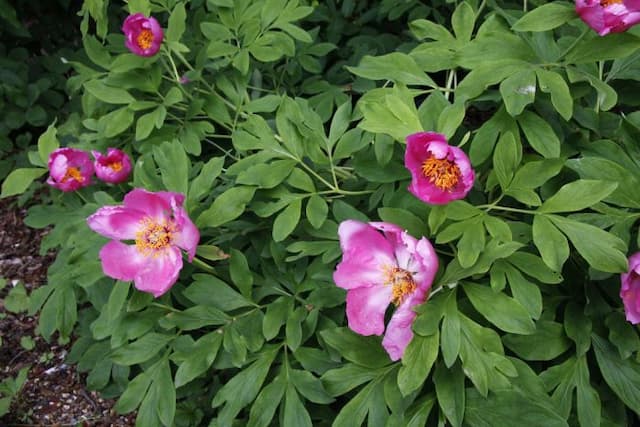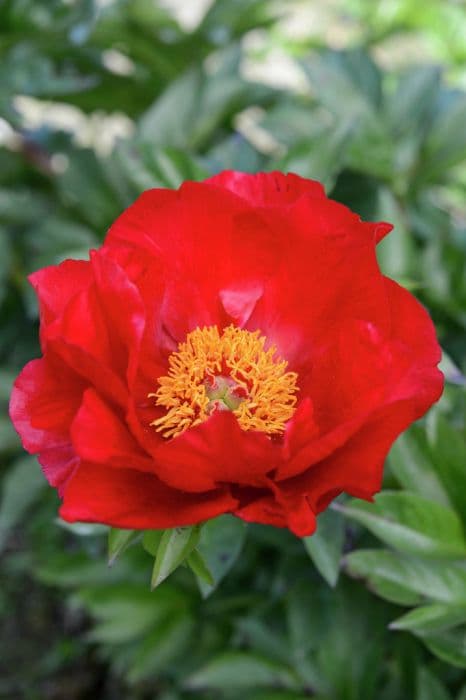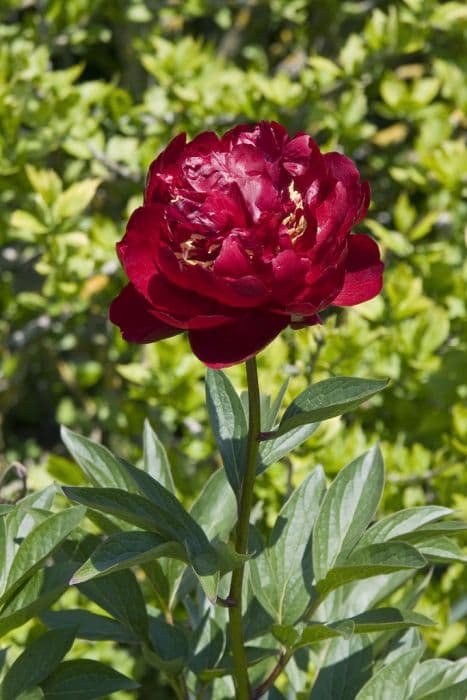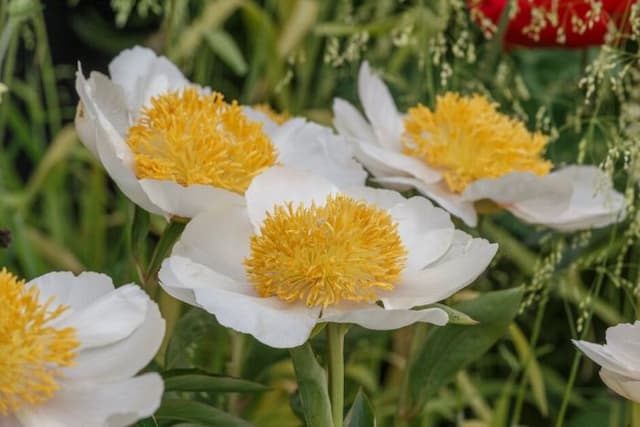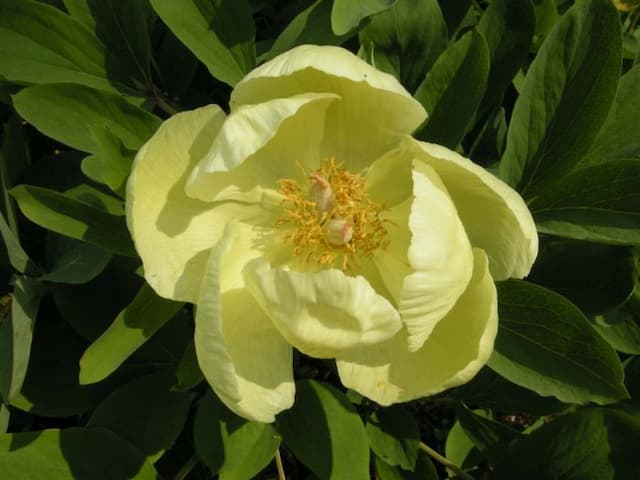Tree peony Paeonia delavayi var. delavayi f. lutea (S)

ABOUT
The plant in question is commonly known as the Chinese tree peony. Featuring lush, deeply lobed leaves that emanate a rich green hue, this ornamental plant presents a striking appearance. The foliage creates a backdrop for its showy flowers, which bloom in a warm, sunny yellow tone, giving it a vibrant and inviting look. The blossoms stand out with their sizable, bowl-shaped form, containing numerous delicate petals that overlap and create a full, textured visual. The striking yellow flowers have a satin-like sheen and may attract attention with their central cluster of contrasting, bold stamens. This plant exudes a certain elegance and is often celebrated for its impressive floral display which adds color and ornamental value to any garden setting where it grows.
About this plant
 Names
NamesSynonyms
Delavay's Tree Peony, Yellow Tree Peony, Chinese Tree Peony
Common names
Paeonia lutea, Paeonia potaninii var. trollioides, Paeonia delavayi f. lutea, Paeonia delavayi var. lutea.
 Toxicity
ToxicityTo humans
The Paeonia delavayi var. delavayi f. lutea, commonly known as the Yellow Tree Peony, generally is not considered highly toxic to humans. However, like many plants, it may cause mild stomach upset if ingested in large quantities. Symptoms might include nausea, vomiting, or diarrhea. It is always prudent to avoid eating any parts of ornamental plants due to potential adverse effects.
To pets
The Yellow Tree Peony (Paeonia delavayi var. delavayi f. lutea) is not widely recognized as a toxic plant for pets. However, ingestion can sometimes lead to gastrointestinal upset in animals, similar to humans. Signs of possible poisoning can include vomiting, diarrhea, and drooling. As pets vary in size and sensitivity, it's best to prevent them from ingesting plant material and to consult a veterinarian if any unusual symptoms arise after ingestion.
 Characteristics
CharacteristicsLife cycle
Perennials
Foliage type
Deciduous
Color of leaves
Green
Flower color
Yellow
Height
4-5 feet (1.2-1.5 m)
Spread
4-5 feet (1.2-1.5 m)
Plant type
Shrub
Hardiness zones
6
Native area
China
Benefits
 General Benefits
General Benefits- Decorative Landscaping: Paeonia delavayi var. delavayi f. lutea, commonly known as Yellow Tree Peony, adds aesthetic appeal to gardens with its large, bright yellow blooms and attractive foliage.
- Habitat Support: This plant provides food and habitat for pollinators such as bees and butterflies, which are essential for the pollination of many garden plants and crops.
- Shade Tolerant: Yellow Tree Peonies can grow in partial shade, making them versatile for different garden layouts.
- Longevity: Yellow Tree Peonies are known for being long-lived perennials, and once established, they can flourish for decades with minimal care.
- Seasonal Interest: With its spring blooms, Yellow Tree Peony adds seasonal interest and provides a visual highlight in the garden during bloom time.
- Drought Tolerance: Once established, they are relatively drought tolerant, reducing the need for frequent watering and maintenance.
- Cold Hardy: Being cold hardy, this plant can tolerate low winter temperatures, making it suitable for planting in a variety of climates.
 Medical Properties
Medical Properties- This plant is not used for medical purposes.
 Air-purifying Qualities
Air-purifying QualitiesThis plant is not specifically known for air purifying qualities.
 Other Uses
Other Uses- As a natural dye: The petals of the Tree Peony can be used to produce a natural yellow dye for fabrics and textiles.
- In cosmetics: The extracts from Tree Peony petals can be used in cosmetic formulations for their natural coloring properties.
- As a botanical illustration subject: Tree Peony's striking flowers make it a favorite subject for botanical artists and illustrators.
- In perfumery: The fragrance of Tree Peony flowers can be captured and used in the making of perfumes and scented products.
- As a garnish: Edible varieties of Tree Peony petals can be used to garnish salads and desserts for an elegant presentation.
- In floral waters: Distilled Tree Peony petals can be used to make floral waters for use in aromatherapy or as a facial toner.
- As a photography subject: The beauty of the Tree Peony makes it a popular choice for photographers, particularly in spring when it blooms.
- In garden design: Tree Peony plants are often used as a focal point in landscape design due to their impressive size and attractive blooms.
- In potpourri: Dried petals of the Tree Peony can be included in potpourri mixes for a delicate fragrance in the home.
- As a symbol in art: The Tree Peony often symbolizes prosperity and honor in art and is therefore used in various artistic decorations and themes.
Interesting Facts
 Feng Shui
Feng ShuiThe Tree Peony is not used in Feng Shui practice.
 Zodiac Sign Compitability
Zodiac Sign CompitabilityThe Tree Peony is not used in astrology practice.
 Plant Symbolism
Plant Symbolism- Prosperity: The Peony, being a lush and abundant flower, is often associated with wealth and good fortune.
- Romance: With its large, perfumed blooms, the Peony is a symbol of love and affection, and is commonly used in wedding bouquets.
- Honor and Compassion: In some cultures, the Peony represents honor and compassion due to its full, round shape and soft texture, conveying a sense of beauty and grace.
- Good Luck and Happiness: The Peony is believed to bring good luck and happiness to the home, making it a popular plant in gardens and as a gift.
 Water
WaterTree peonies like Paeonia delavayi var. delavayi f. lutea need regular watering to establish deep root systems, especially during their first few years. Once established, water them deeply every week during dry spells, providing about 1 to 2 gallons per plant to ensure moisture reaches deep into the soil. Reduce watering in the fall to prepare the plant for dormancy, and avoid overwatering as this can lead to root rot
 Light
LightTree peonies including Paeonia delavayi var. delavayi f. lutea thrive in spots with full sun to partial shade. They require at least six hours of sunlight per day, but in regions with very hot summers, some afternoon shade can prevent overheating. The ideal location offers morning sun, which helps to dry dew off the leaves, reducing the risk of fungal diseases
 Temperature
TemperatureTree peonies, such as Paeonia delavayi var. delavayi f. lutea, are hardy and can tolerate temperatures as low as -20°F and as high as 90°F. For optimal growth, maintain a temperature range between 65°F and 75°F. Be sure to provide winter protection if temperatures consistently fall below the survival threshold
 Pruning
PruningTree peonies such as Paeonia delavayi var. delavayi f. lutea require minimal pruning, primarily to remove dead or damaged wood and to shape the plant. Prune in late winter or early spring before new growth begins. You can also deadhead spent blooms after flowering to improve plant appearance, but avoid cutting into woody stems, as this can reduce next year's blooms
 Cleaning
CleaningAs needed
 Soil
SoilTree Peony prefers a well-draining loamy soil with a slightly acidic to neutral pH of 6.5 to 7.0. The best soil mix can be created by combining two parts garden soil, one part well-rotted compost, and one part perlite or coarse sand to improve drainage.
 Repotting
RepottingTree Peonies do not need frequent repotting and can be repotted every three to five years, as they prefer not to be disturbed often. Ensure that the new pot is only slightly larger than the previous one.
 Humidity & Misting
Humidity & MistingTree Peonies do not have specific humidity requirements and can tolerate the humidity levels typically found in temperate climates. It is more important to provide adequate air circulation to prevent foliar diseases.
 Suitable locations
Suitable locationsIndoor
Provide bright indirect light, cool temps, and well-draining soil.
Outdoor
Plant in full sun to part shade with shelter from strong winds.
Hardiness zone
4-8 USDA
 Life cycle
Life cyclePaeonia delavayi var. delavayi f. lutea (S), more commonly known as the Yellow Tree Peony, begins its life cycle as a seed, which requires stratification—a period of cold treatment to break dormancy. After stratification, seeds germinate and develop into seedlings, characterized by the emergence of the first true leaves. As the seedlings grow, they establish a strong root system and eventually form a woody stem, marking the transition from seedling to a young plant. The Yellow Tree Peony may take several years to bloom for the first time as it matures into an adult plant, featuring its distinctive large, yellow flowers. During its reproductive phase, the plant is pollinated by insects, leading to seed formation if the flowers are fertilized. Finally, after blooming from late spring to early summer, the plant enters a period of dormancy in the fall, shedding its leaves and conserving energy for the next growing season.
 Propogation
PropogationPropogation time
Spring to summer
Paeonia delavayi var. delavayi f. lutea, commonly known as the yellow tree peony, is most commonly propagated by grafting, which is typically performed in late summer or early fall. In this process, a piece of the peony's rootstock, usually from a herbaceous peony, is joined with a piece of the yellow tree peony's stem that includes a bud. The two pieces are precisely cut to fit tightly together and are then wrapped and bound to keep the join secure. Over time, the tissues of the two plants grow together, creating a single plant that combines the strong root system of the herbaceous peony with the desirable flowering characteristics of the yellow tree peony. Grafting is favored for yellow tree peonies because it provides a reliable means of clonal reproduction, ensuring the new plants will bear flowers identical to the parent plant.
